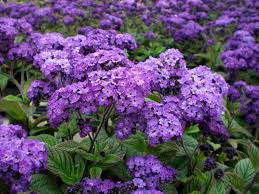heliotrope
英 ['hiːlɪətrəʊp; 'hel-]
美 ['hɛlɪətrop]
- n. 天芥菜属植物;[植] 向阳植物;淡紫色;鸡血石
GRE
heliotrope 天芥菜helio-,太阳的,-trope,转,词源同turn,tropic.即转向太阳的花或植物,古义也用于指向日葵,现特定指天芥菜属植物。
- heliotrope
- heliotrope: [17] The heliotrope, a plant of the forget-me-not family, gets its name because its flowers always turn to face the sun (the word comes via Latin hēliotropium from Greek hēliotrópion, a compound formed from hélios ‘sun’ and -tropos ‘turning’ – as in English trophy and tropical – which designated such plants, and was also used for ‘sundial’).
In early times the word was applied to the ‘sunflower’, which has similar heliotactic habits and in Italian is called girasole (literally ‘turn-sun’), source of the Jerusalem in English Jerusalem artichoke. Another application of Greek hēliotrópion carried over into English was to a sort of green quartz which was believed to turn the sun’s rays blood-red if thrown into water.
=> trophy, tropical - heliotrope (n.)
- "plant which turns its flowers and leaves to the sun," 1620s, from French héliotrope (14c.) and directly from Latin heliotropium, from Greek heliotropion, from helios "sun" (see sol) + tropos "turn" (see trope). The word was applied c. 1000-1600 in Latin form to sunflowers and marigolds. Related: Heliotropic.
- 1. She put her nose luxuriously buried in heliotrope and tea roses.
- 她把自己的鼻子惬意地埋在天芥菜和庚申蔷薇花簇中。
来自辞典例句
- 2. So Laurie played and Jo listened, with her nose luxuriously buried in heliotrope and tea roses.
- 这样劳瑞便弹了起来.裘把自己的鼻子惬意地埋在无芥菜和庚申蔷薇花簇中倾听着.
来自辞典例句
- 3. Notes of heliotrope flowers and vanilla - combine to create the warm floral base notes.
- 天芥草及云呢拿 - 混合为散发温暖花香的基调.
来自互联网
[ heliotrope 造句 ]
